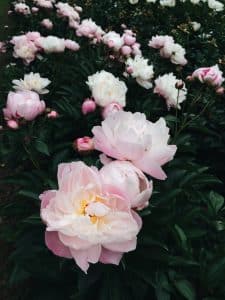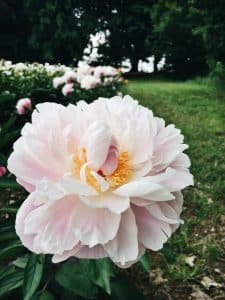The golly flower is an herbaceous perennial better known for some of its common names like the white peony or the Chinese peony. In some cases, it’s even called the garden peony. This stunning, showy flower is a hardy, fragrant plant ideal for springtime beauty.

| Botanical Name | Paeonia Lactiflora |
| Common Name | Golly, peony golly, white peony, Chinese peony |
| Plant Type | Perennial shrub |
| Flower Color | Showy, fragrant flowers in pink and white |
| Size When Mature | 24-36 in. Spread |
| Bloom Time | Late spring to early summer |
| Sun Requirements | Full sun/part shade |
| USDA Hardiness Zones | 3a – 8a |
| Soil PH Range | Acid, alkaline, neutral |
| Soil Type | Rich, well-draining soil |
| Water Needs | Average |
| Native Area | China, Siberia |
What You Need To Know About the Golly Flower
The golly flower is a medium-sized shrub known for its substantial springtime blossoms. The flowers bloom in lovely shades of white and pink, featuring bold yellow stamens in the middle. The petals are layered and fluffy, offering a full, round bloom.
You can expect the plant’s flowers to bloom starting in the spring and continuing through the early summer. One flower will last anywhere from 7 to 10 days, making them excellent as cut flowers.
In addition to its beauty, the golly flower’s roots are known to have certain medical benefits.
How To Care for the Golly Flower
Here’s everything you need to know about growing and caring for a thriving golly flower.
Light
The golly flower enjoys full sun or partial shade. Full sun is best, but the plant will tolerate a little bit of shade throughout the day.
Water and Soil Needs
Golly flowers do best when planted with a good amount of space between them – up to four feet, to be safe. These plants prefer to keep the tops of their roots near the surface.
Although the peony plant is tolerant of many different soil types, they need a well-draining location to avoid pooling and root rot. For best results, plant in a neutral pH.
If the golly flower is in an area that sees regular rainfall, extra watering isn’t necessary. But during dry conditions, one inch of water weekly does best to keep the soil evenly moist as needed.
Temperature Requirements
This particular peony plant does not prefer very hot, humid areas. It thrives in zones 3 through 7 and sometimes 8 in northern areas, but the blooms don’t last long in high temperatures.
Instead, this perennial does well in cooler climates. The plant can withstand temperatures as low as negative 50 degrees. In fact, the cold weather supports dormancy necessary for new bud growth.
Fertilizer
Fertilizer isn’t necessary for golly flowers, as long as the soil has enough natural nutrients to support their growth. However, you can grow this peony in poor soil with the right kind of fertilizer. Aim for a low-nitrogen option, like bulb fertilizer.
If planted in sandy or clay soil, you can also add organic matter other than manure. Mix fertilizers in with the soil deeply.
Common Diseases
The golly flower is most susceptible to fungal diseases, especially botrytis blight. These diseases happen when the plant is exposed to too much moisture, especially during the cooler months.
This common peony rarely gets serious pest problems, but it may succumb to mildew on its leaves and stems in humid weather.
Golly Flower Propagation
Golly flowers have rhizomatous root clumps, so to propagate them, you must divide the clump. It’s best to do this during the fall when pruning the plant. Dig up the plant and use a knife to divide the root. Be sure to keep between three and five growth eyes on the cut portion.
Replant the original plant and plant the new root elsewhere, ensuring plenty of space between plants. Bury it no deeper than two inches. Allow for up to three years to see a mature plant with flowers.

